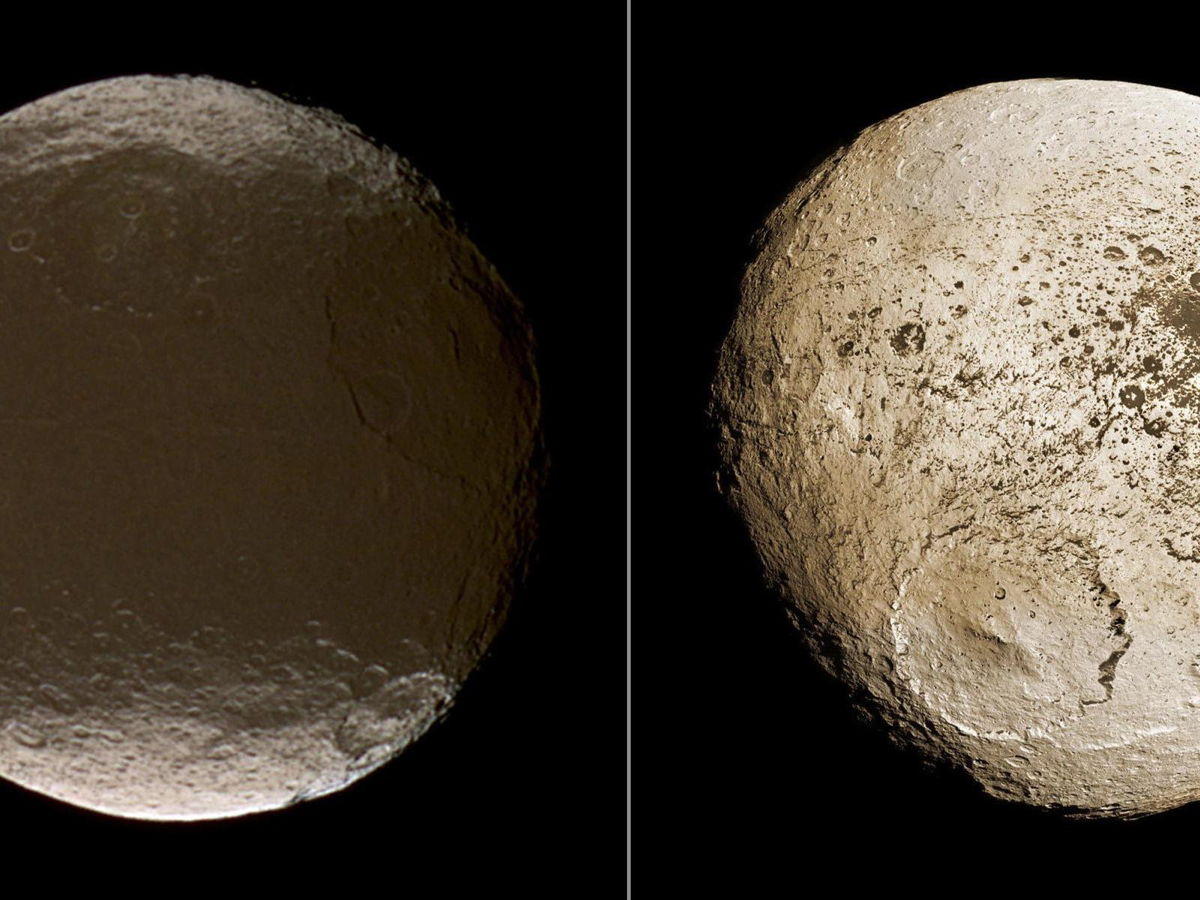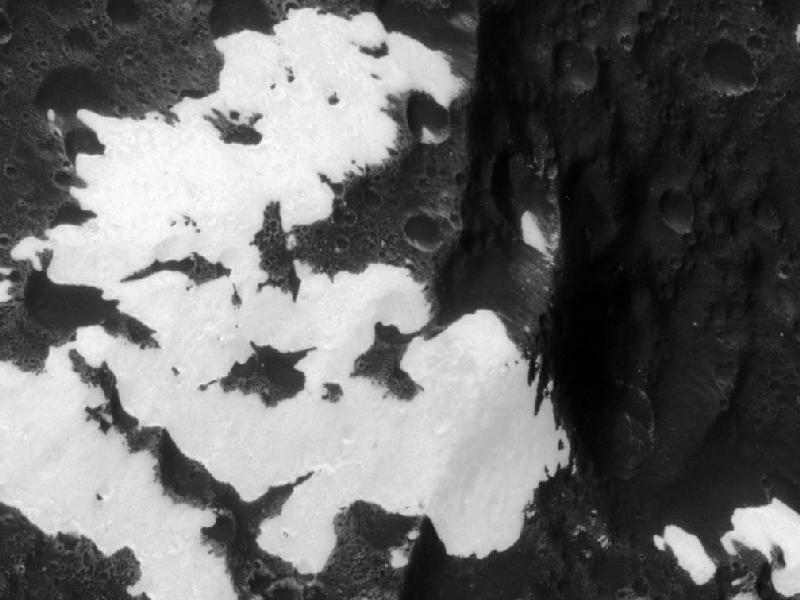Iapetus: Saturn's Yin-Yang Moon
The light and dark faces of Saturn's moon Iapetus create a contrast that helped to hide the satellite for years, despite its distant orbit. The moon, which keeps the same face perpetually turned toward Saturn, remained shrouded in shadows, with its bright side only visible from Earth when it traveled on the west side of its primary.
Discovery and naming
Iapetus is one of four moons discovered by Giovanni Cassini in 1672. But the icy moon challenged the Italian astronomer. He first spotted it on the west side of the planet, but when he attempted to observe it 39 days later on the eastern side, no trace of the satellite could be found. The pattern repeated itself over the course of the moon's 79-day orbit, leading Cassini to surmise that the moon was tidally locked, with one face darker than the other.
Cassini named the four moons that he discovered (Iapetus, Rhea, Dione, and Tethys) the Sidera Lodoicea, or the Stars of Louis, after King Louis XIV. For years, the moons were referred to numerically, based on their distance from Saturn. Distant Iapetus started out as Saturn V, but the discovery of Mimas, Enceladus, and Hyperion bumped it down to Saturn VIII. Nearly 200 years later, John Herschel suggested that the moons around the ringed planet be named for the Titans, the siblings of the Greek god Cronus, who was Saturn to the Romans.
In Greek mythology, Iapetus is a son of Uranus and Gaia and the father to Atlas and Prometheus. His relationship to Prometheus, the Titan who gave fire to humans, led early Greeks to regard Iapetus as the father of the human race.
Features on Iapetus take their names from the French epic poem "The Song of Roland."
Composition and orbit
Iapetus has a low density of only 1.083 grams per cubic centimeter, just a little more than liquid water, implying that it composed primarily of water, with rock making up less than a quarter of its composition. The walnut-shaped moon is not spherical, but has a bulging equator with squashed poles. The squashed shape of the moon resembles a satellite that rotates once every 10 hours, rather than the 79 days it takes Iapetus to make a full revolution.
The angular structure of the moon has led to conspiracy-like suggestions that it is not a natural satellite but could have been built or modified by another civilization. However, its odd shape could easily have a natural explanation. Early in its life, when the moon still spun rapidly, a thick crust could have frozen the moon into its odd shape. Over time, the satellite's spin would have slowed until it eventually became tidally locked.
Breaking space news, the latest updates on rocket launches, skywatching events and more!
Iapetus is the third-largest moon orbiting Saturn, with a diameter of 914 miles (1,471.2 km). Although its radius is about two-fifths that of Earth's moon, its icy composition means that it is only about 2 percent as massive.
A chain of high mountains circle the equator, stretching more than halfway around the moon, though in it may have encircled it completely long ago. The ridge stretches more than 800 miles (1,300 km) around the moon's 2,871-mile (4,621 km) equatorial circumference. Some of the peaks reach heights exceeding 12 miles (20 km), making them among the highest mountains in the solar system.
A line of white dots making up the ridge, informally called the Voyager Mountains, was first spotted and studied in the early 1980s by the spacecraft of the same name. Years later, NASA's Cassini probe studied the ridge in depth. The white dots spotted by Voyager were not peaks but regions of ice on their eastern sides. The other mountains are covered with dark material. The Voyager Mountains reach as high as 6 miles (10 kilometers).
The ridge wrapped around Iapetus' equator may have formed early in its history, when the moon spun faster than it does today. It may also have been created from material deposited by a ring or moon that collapsed onto the satellite.
Iapetus travels around Saturn at a distance of 2,213,000 miles (13,561,300 km) from Saturn, the most distant of its major satellites. Unlike other, closer moons, Iapetus suffers very little tidal heating from the massive planet. As a result, the skin of the satellite does not show signs of melting and resurfacing that may have smoothed the outer layer of other moons.
There are, however, other signs of change on its surface. In 2012, scientists announced they had detected landslides of up to 50 miles. These were likely generated when material fell from a great height and travelled a long way in the light gravity of the moon. Given that Iapetus does have a high peak and the longest landslides were associated with the ridge (and related features), it's likely this would have been the cause. Scientists are hoping to learn more about this feature to better explain similar events on Earth and Mars.
Both hemispheres contain a number of impact craters of varying sizes. The largest, Turgis, has a diameter of about 360 miles (580 km).
The dark side of the moon
The most striking feature of Iapetus is its contrasting coloration. The leading hemisphere of the satellite is coal-black, while its backside is far brighter. As Cassini noticed, when the moon is facing Earth, its dark leading side helps to keep it hidden. The coal black region is called Cassini Regio, in honor of the Italian astronomer.
A number of theories seek to explain the strangely contrasting satellite. Particles from the smaller but more distant moon, Phoebe, may fall on the surface of Iapetus, constantly renewing the dark side. Eruptions of dark hydrocarbons from ice volcanoes could also explain the differentiation.
Evidence for that theory came in 2009. Scientists detected a ring of material surrounding Saturn that likely came from Phoebe. By 2015, infrared observations from NASA's WISE spacecraft showed the Phoebe ring was a lot larger than previously expected. Its distance ranges from 100 to 270 times the radius of Saturn, or about 3.75 million to 10.1 million miles (6 million to 16.2 million km) from the planet.
Thermal observations of the moon taken by the Cassini mission provide the best insight into the unique process. The slow rotation of the moon means that the dark surfaces, which absorb more heat than their icy counterparts, have more time to warm. Any icy material mixed with the dark surfaces is reduced to gaseous form, falling back on the cooler regions of the moon. The dark side then continues to grow darker, while the bright side grows brighter.
The process could have started long ago, with only a small amount of dark material to fuel it. As the material separated, the dark patch could have grown steadily over time, resulting in the yin-yang moon seen today. Scientists are not only looking at Iapetus and modeling it to explain the theory, but they have also tried comparing it to microwave emissions tracked on Earth. The key limitation is that ice on Earth melts into liquid water, so the team acknowledged that more study on this matter was required. Other locations that could serve as a point of comparison include the moons of Jupiter and the small, icy bodies of the Kuiper Belt beyond Neptune.
Temperatures on the warmer dark side reach minus 143 degrees C (minus 226 F). The bright side, which absorbs less heat, is cooler, with temperatures averaging minus 173 C (minus 280 F).
Quick facts
- Average orbital distance: 2,212,610 miles (3,560,851 km)
- Closest approach: 2,147,780 miles (3,456,518 km)
- Farthest approach: 2,277,440 miles (3,665,184 km)
- Orbit eccentricity: 0.0293
- Mean radius: 457 miles (735.6 km)
- Escape velocity: 1,280 mph (2,061 kph)
— Additional reporting by contributor Elizabeth Howell.

Nola Taylor Tillman is a contributing writer for Space.com. She loves all things space and astronomy-related, and always wants to learn more. She has a Bachelor's degree in English and Astrophysics from Agnes Scott College and served as an intern at Sky & Telescope magazine. She loves to speak to groups on astronomy-related subjects. She lives with her husband in Atlanta, Georgia. Follow her on Bluesky at @astrowriter.social.bluesky



